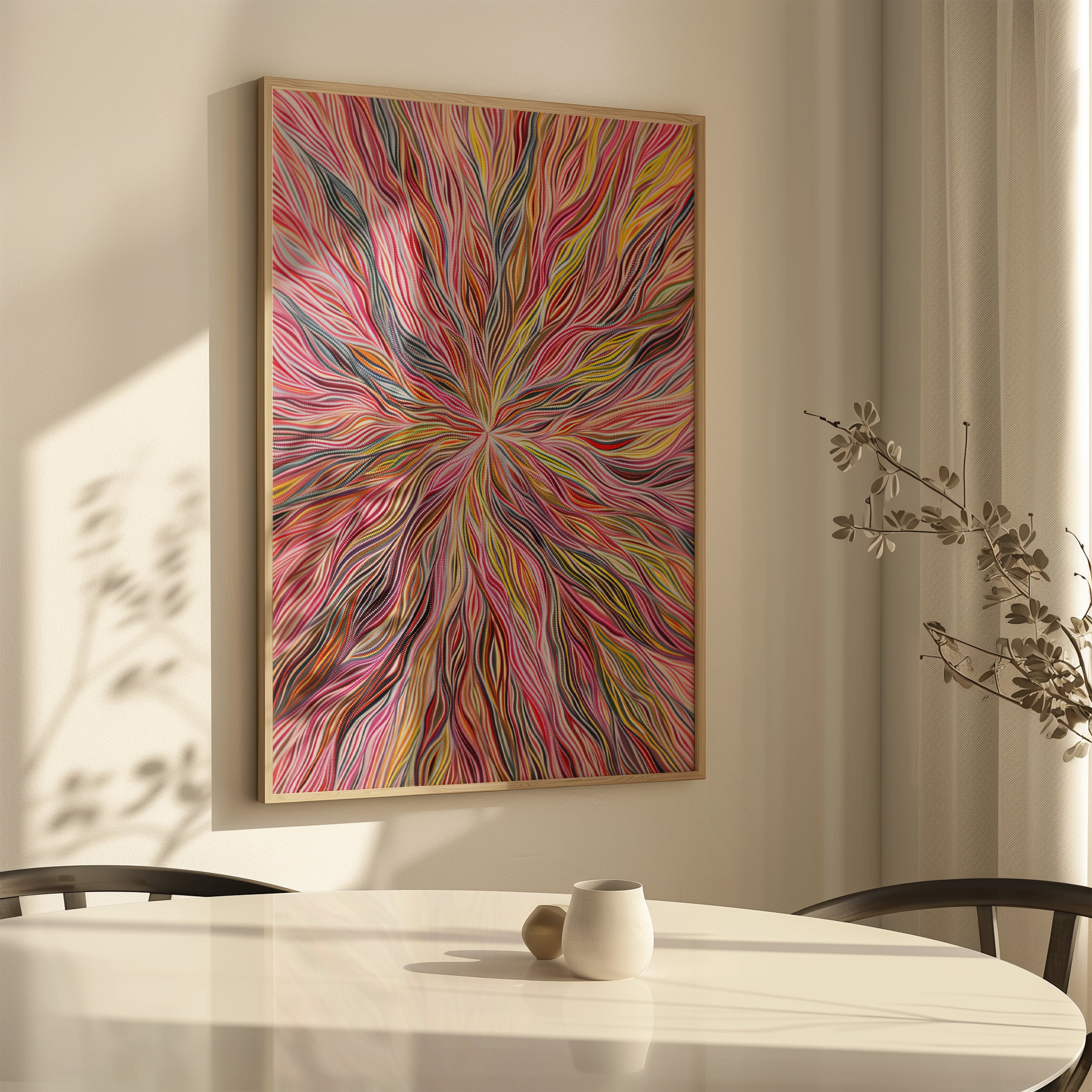
Aboriginal Australian art is a vibrant and diverse cultural expression that has flourished for thousands of years. This art is deeply rooted in the spiritual beliefs, stories, and traditions of Australia’s First Nations peoples, with each style reflecting the unique cultural landscape of the region from which it originates. As we explore the different styles of Aboriginal Australian art, we gain a deeper appreciation for the complexity, diversity, and richness of this ancient and evolving tradition.
1. Dot Painting (Western Desert Art)
One of the most recognized styles of Aboriginal art is dot painting, primarily associated with the Western Desert region of Australia. This style originated in the early 1970s when artists from the Papunya Tula community began using acrylic paints on canvas to depict traditional stories and Dreamtime narratives.
- Characteristics: Dot paintings are created using small, closely placed dots of paint, often in earthy colors like ochre, red, white, and black. The dots form intricate patterns and shapes, representing landscapes, animals, and sacred sites. The dotting technique also serves to obscure sacred knowledge, protecting it from uninitiated viewers.
- Significance: This style is not just decorative but deeply symbolic, with each pattern and color conveying specific cultural meanings. Dot paintings often represent the journeys of ancestral beings, waterholes, animal tracks, and other elements crucial to the Dreamtime.
2. Cross-Hatching (Rarrk) and X-Ray Art
The cross-hatching technique, known as Rarrk, is characteristic of the art from Arnhem Land in Northern Australia. This style, along with X-ray art, is distinctive for its detailed and intricate designs.
- Characteristics: Rarrk involves fine, parallel lines of color, often applied with a thin brush made from human hair. These lines are layered to create a shimmering, almost three-dimensional effect. X-ray art, on the other hand, depicts the internal organs and skeletal structures of animals and humans, as if seen through an X-ray.
- Significance: Both styles are used to represent stories of creation, ancestral beings, and the natural world. The X-ray technique reflects the deep knowledge Aboriginal people have of the anatomy and biology of the animals they depict, while Rarrk often symbolizes the spiritual energy or essence of the subject.
3. Wandjina and Bradshaw (Gwion Gwion) Figures
The Kimberley region of Western Australia is known for its unique rock art styles, particularly the Wandjina and Bradshaw (Gwion Gwion) figures.
- Wandjina Art: Wandjina are cloud and rain spirits, depicted as large, human-like figures with no mouths, large eyes, and elaborate headdresses. These figures are often painted in white ochre on rock surfaces and are associated with fertility, rainmaking, and the control of the weather.
- Bradshaw (Gwion Gwion) Figures: These ancient and enigmatic figures, believed to be up to 17,000 years old, are characterized by their dynamic, graceful postures and intricate clothing and adornments. The figures often appear in action poses, such as dancing or hunting, and are painted in dark red ochre.
- Significance: Both styles are deeply spiritual, with Wandjina figures still actively worshipped and maintained by Aboriginal people today. The Bradshaw figures, while less understood, are believed to represent early ancestral spirits or totemic beings.
4. Carved and Painted Poles (Pukumani Poles and Memorial Poles)
In the Tiwi Islands and Arnhem Land, carved and painted poles play a significant role in ceremonial practices, particularly in funerary and memorial rituals.
- Pukumani Poles: These are grave posts used in Pukumani ceremonies, which are traditional burial rites of the Tiwi people. The poles are intricately carved and painted with bold patterns and colors, symbolizing the deceased’s life, clan, and spiritual journey.
- Memorial Poles: In Arnhem Land, memorial poles are similarly carved and painted, often representing the connection between the deceased and the spiritual world. These poles can also serve as markers of significant events or places.
- Significance: These poles are not just artistic objects but are imbued with spiritual significance, representing the connection between the physical and spiritual realms. The patterns and colors used on the poles convey messages about the deceased’s life and their passage into the afterlife.
5. Bark Painting
Bark painting is a traditional art form from Arnhem Land and parts of Northern Australia, where artists paint on strips of bark peeled from trees, usually eucalyptus.
- Characteristics: These paintings often depict animals, ancestral beings, and Dreamtime stories. The bark is first flattened and then painted using natural ochres, with intricate patterns and symbolic representations filling the surface.
- Significance: Bark paintings are highly symbolic, with each design connected to the artist’s clan and the stories of their land. These works are often created as part of ceremonial practices and are used to pass down knowledge through generations.
6. Contemporary Aboriginal Art
In recent decades, Aboriginal art has expanded to include contemporary forms, with artists blending traditional symbols and stories with modern techniques and mediums.
- Urban Aboriginal Art: Many Aboriginal artists in urban areas explore themes of identity, displacement, and social justice. Their works often incorporate graffiti, digital media, and photography, merging traditional Aboriginal symbols with contemporary issues.
- Installation and Performance Art: Some contemporary Aboriginal artists use installation and performance art to engage with audiences in new ways, addressing political and cultural issues while still honoring their heritage.
- Significance: Contemporary Aboriginal art reflects the adaptability and resilience of Aboriginal culture, showing how ancient traditions can evolve and remain relevant in the modern world.
The different styles of Aboriginal Australian art highlight the diversity and richness of Aboriginal culture across various regions. Each style, whether ancient or contemporary, serves as a powerful medium for storytelling, spiritual expression, and cultural preservation. By exploring these styles, we not only appreciate the aesthetic beauty of Aboriginal art but also gain a deeper understanding of the cultural and spiritual significance that underpins this ancient and ongoing tradition.





